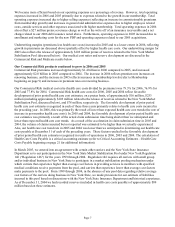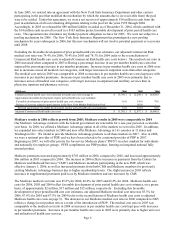Aetna 2006 Annual Report Download - page 19
Download and view the complete annual report
Please find page 19 of the 2006 Aetna annual report below. You can navigate through the pages in the report by either clicking on the pages listed below, or by using the keyword search tool below to find specific information within the annual report.Page 17
Risk Management and Market-Sensitive Instruments
We manage interest rate risk by seeking to maintain a tight match between the durations of our assets and liabilities
where appropriate. We manage credit risk by seeking to maintain high average quality ratings and diversified sector
exposure within our debt securities portfolio. In connection with our investment and risk management objectives,
we also use derivative financial instruments whose market value is at least partially determined by, among other
things, levels of or changes in interest rates (short-term or long-term), duration, prepayment rates, equity markets or
credit ratings/spreads. Our use of these derivatives is generally limited to hedging purposes and has principally
consisted of using interest rate swap agreements, warrants, forward contracts and futures contracts. These
instruments, viewed separately, subject us to varying degrees of interest rate, equity price and credit risk. However,
when used for hedging, we expect these instruments to reduce overall risk. Refer to Liquidity and Capital
Resources below and Note 15 of Notes to Consolidated Financial Statements beginning on page 76 for additional
information.
We regularly evaluate our risk from market-sensitive instruments by examining, among other things, levels of or
changes in interest rates (short-term or long-term), duration, prepayment rates, equity markets or credit
ratings/spreads. We also regularly evaluate the appropriateness of investments relative to our management-
approved investment guidelines (and operate within those guidelines) and the business objectives of our portfolios.
The risks associated with investments supporting experience-rated pension and annuity products in our Large Case
Pensions business are assumed by those contract holders and not by us (subject to, among other things, certain
minimum guarantees). Anticipated future losses associated with investments supporting discontinued fully
guaranteed large case pensions products are provided for in the reserve for anticipated future losses on discontinued
products (refer to Large Case Pensions - Discontinued Products beginning on page 13).
Management also reviews, on a quarterly basis, the impact of hypothetical net losses in our investment portfolio on
our consolidated near-term financial position, results of operations and cash flows assuming the occurrence of
certain reasonably possible changes in market rates and prices. We determine the potential effect of interest rate
risk on near-term net income, cash flow and fair value based on commonly used models. The models project the
impact of interest rate changes on a wide range of factors, including duration, prepayment, put options and call
options. We also estimate the impact on fair value based on the net present value of cash flows using a
representative set of likely future interest rate scenarios. The assumptions used were as follows: an immediate
increase of 100 basis points in interest rates (which we believe represents a moderately adverse scenario and is
approximately equal to the historical annual volatility of interest rate movements for our intermediate-term
available-for-sale debt securities) and an immediate decrease of 25% in prices for domestic equity securities.
Based on our overall exposure to interest rate risk and equity price risk, we believe that these changes in market
rates and prices would not materially affect our consolidated near-term financial position, results of operations or
cash flows as of December 31, 2006.
LIQUIDITY AND CAPITAL RESOURCES
Cash Flows
Generally, we meet our operating requirements by maintaining appropriate levels of liquidity in our investment
portfolio and using overall cash flows from premiums, deposits and income received on investments. We monitor
the duration of our portfolio of debt securities (which is highly marketable) and mortgage loans, and execute
purchases and sales of these investments with the objective of having adequate funds available to satisfy our
maturing liabilities. Overall cash flows are used primarily for claim and benefit payments, contract withdrawals
and operating expenses.
Presented below is a condensed statement of cash flows for the years ended December 31, 2006, 2005 and 2004.
We present net cash flows used for operating activities of continuing operations and net cash flows provided by
investing activities separately for our Large Case Pensions segment, because changes in the insurance reserves for
the Large Case Pensions segment (which are reported as cash used for operating activities) are funded from the sale
of investments (which are reported as cash provided by investing activities). Refer to the Consolidated Statements
of Cash Flows on page 46 for additional information.
























